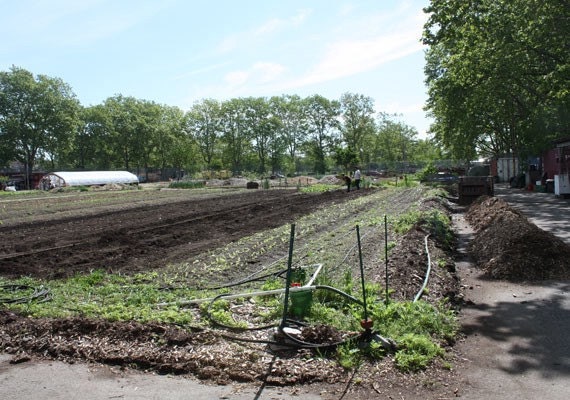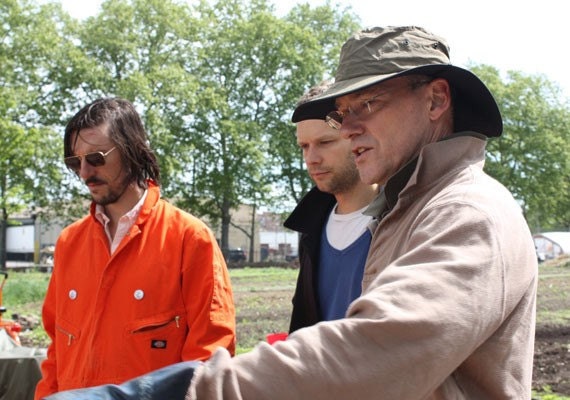Editor's note: This article was originally published in the Etsy News blog on August 3rd, 2012.
If you're around DUMBO, Brooklyn on a Friday morning, you just might stumble upon a strange and seemingly silly sight: a small group of Etsy Admin on bikes, outfitted in full-body jumpsuits and helmets, about to embark on what's become a routine mission — taking our office compost to the farm.
They ride alongside the little orange Etsy wagon loaded up with bags of more than a hundred pounds of sludge: discarded coffee grinds, ripped-up paper plates, flower stems, brown paper towels, apple cores and decaying orange peels. Bumping along the cobblestone street, they make their way to the scenic bike path just past Brooklyn Bridge Park and head south toward Red Hook Community Farm. There, they'll compost the week's collection and help turn it into nutrient-rich soil that's perfect for growing fruits and vegetables.
The weekly trek is part of Etsy's composting program, which began last August and, as of June, brings in a monthly average of more than 600 pounds. Though Etsy has experimented with composting in the past, the most recent program began when office ecologist Jakob — in a quest to find the “noble side to garbage” — teamed up with local compost enthusiasts, eager to create a program with a higher impact.


The view at Red Hook Community Farm.
“I was looking for a way to minimize our wasteful ways, lower the carbon footprint and curb our modern decadence,” he says. “I approached my trusty composting friend (and expert) Louise Bruce of Compost for Brooklyn. She shared her secret knowledge with me and in turn introduced me to David Buckel, master composter extraordinaire of the Red Hook Community Farm. He then welcomed Etsy to his magic kingdom of composting.”
A large majority of the material we take to Red Hook comes from Eatsy — Etsy's biweekly company lunch — which is served on compostable Bagasse plates. The plates are made from byproducts of the sugar cane industry, and break down completely in about two and a half weeks. After lunch, Admin form a line in the kitchen to scrape their plates and rip them into quarters, discarding them in the large compost bin. Roughly 280 plates are quartered and added to the pile at every Eatsy. That's more than 2,200 plates per month that are going directly back into the soil to cultivate harvests here in Brooklyn!
“If you really think about it for a second, it's magic,” Jakob says. “Stinky trash transforms into a magnificent substance that helps feed and grow things we love — and love to eat.”


David and Jakob explain windrows to Etsy Admin Josh.
Other compostable materials, such as tea bags, strawberry tops, grape vines, banana peels and avocado skins are added to the bin during the week as well. Signs taped up in the kitchen remind Admin and their guests of what's compostable. Once the bin fills up, the material is stored until Friday when Jakob leads the crew to Red Hook.
At the farm, David and Jakob team up to teach the Admin volunteers more about the process. Red Hook Community Farm's primary method of composting is to create windrows, which are pyramid-like rows of organic matter that is mixed together to ensure the fastest and highest quality of composting. The trick lies in the ratio of carbon to nitrogen-rich content, Jakob explains. It has to be just right in order to promote the bacterial bloom, which accelerates the decomposition process. David and his team have to monitor the temperature constantly to ensure maximum compostablility. The process is delicate, but contributing to our community through recycling is a way for us to uphold the values upon which Etsy was founded.


Etsy Admin return to DUMBO after a morning at the farm.
“I cannot begin to tell you guys how important and excellent a thing composting is,” Jakob said in a company-wide email when the program started. “Not only does it lessen the amount of trash we send to our jam-packed landfills — where even biodegradable waste often can't break down (no oxygen) and instead just stays, taking up space and producing methane and C02 (both greenhouse gasses) — but it also makes use of this waste.”
Etsy's composting program is one more step in our efforts to walk the walk. We take our B Corporation certification seriously, and are always on the lookout for new ways to improve our collective carbon footprint. Many members of our community have long understood the power of business for good — using recycled packaging or promoting buying locally — and we can only hope to do them proud.
It's good for the environment, good for us (bike ride and fresh produce, anyone?), and it's fun! There are several ways to get involved in composting — you could volunteer at your local farm, or buy produce from a local source that grows in composted soil. If you live in the US, you can participate in a regional or state composting program. You could encourage your workplace, school or community center to make the switch from Styrofoam plates to eco-friendly Bagasse plates. Or, create your own compost pile at home (and invite friends over to help out!).
How will you get involved?
